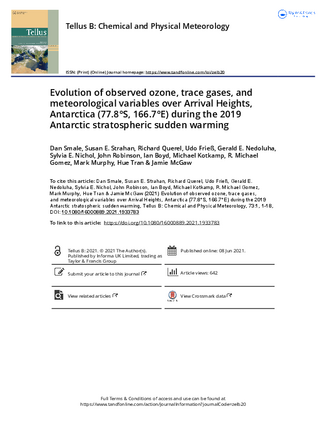We use ground-based spectroscopic remote sensing measurements of the stratospheric trace gases O3, HCl, ClO, BrO, HNO3, NO2, OClO, ClONO2, N2O and HF, along with radiosonde profiles of temperature to track the springtime development of the 2019 ozone hole over Arrival Heights (77.8°S, 166.7°E, AHTS), Antarctica, during, and after, the 2019 stratospheric sudden warming (SSW) event. Both measurements and model simulations show that the 2019 SSW caused an extraordinarily warm stratosphere within the polar vortex, resulting in record low ozone depletion over AHTS. We also contrast the evolution of the 2019 ozone hole to that in 2002, which also had a major springtime SSW event.
The SSW event started around 28th August. By ∼17th September, stratospheric temperatures inside the polar vortex over AHTS were ∼45 K higher than the climatological average. The SSW did not cause an en masse displacement of mid-latitude air over AHTS as in the 2002 SSW event. However, the increased temperatures did cause an unusually early reduction in polar stratospheric clouds, halting the denitrification early and leading to increased gas-phase HNO3 and record high levels of NO2 (‘renoxification’). This caused the earliest observed deactivation of chlorine, returning all active chlorine into the chlorine reservoir species, HCl and ClONO2. The deactivation rate into HCl remained relatively unaffected by the SSW, whilst there was a dramatic increase in ClONO2 formation. This chlorine deactivation pathway via ClONO2 is typical of the Arctic and atypical for the Antarctic.
At AHTS, record high levels of springtime ozone were observed. The measured ozone total column did not drop below 220 DU. Record high stratospheric temperatures persisted until 7th October over AHTS. By 22nd October, AHTS was not beneath the polar vortex. The polar vortex break-up date on 9th November was one of the earliest observed.
